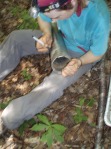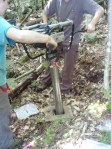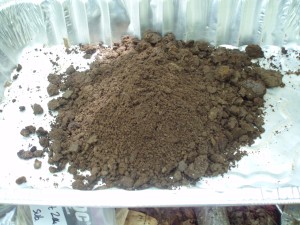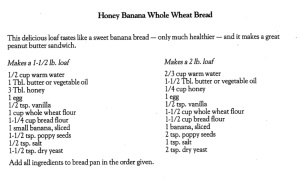Filed under: Soil Power Coring
As of yesterday, the Shoestring crew finished it’s 100th power core for the field season! This was capstoned by April finishing root sorting in the lab by 9 pm last night. The crew anxiously awaits the due-to-arrive new drill bit, as even diamond studded steel doesn’t hold a tooth to New Hampshire granite.
40 cores in two stands to go…
Taking soil cores with a power corer and a power house! by Gavin MacKellar
At the start of last week, 7/12, April arrived from Cornell with the
power corer to start taking soil samples from sites HB Mid, HB Old, JB
Mid, JB Old, C3, C5 and C7. Within each of these sites April, with
extensive help from the field crew, will take five soil cores from
each plot. One core will be in the very center of the plot and the
remaining four will be placed in the buffer (for minimal disturbance)
at each plot corner. Each soil core is 50cm into the mineral layer
and including the Organic layers above it. The organic layers are
sampled as Oi & Oe and the second sample as the Oa.
After this the mineral layer is exposed and the increments measured for samples are 0-10cm, 10-20cm, 20-30cm, 30-50cm soil and roots. These depth measurements are marked on the corer in marker.

At each depth increment the sample is removed and placed in its appropriate and labeled bag, with the core half way done.
After each sample is taken the corer is reinserted into the core hole and drilled to the appropriate depth then removed, repeating the process. After each core the hole is measured to double check the depth and April scoops out any loose soil from the bottom of the core, which by the end can be really deep to reach. For the 30-50cm core the sample is divided into two, the extra being for root sampling. Once the samples have been taken there is a total of eight bags of samples from each power core. Taking eight (big) samples from each core and taking five cores per plot, the amount of soil samples adds up very quickly and is quite a heavy load to carry out of the plot.

Once all the soil samples are removed a smooth core into the soil is left behind. The power corer has the ability to cut through small rocks and sometimes, with persistence, big rocks. Additionally with a bit of misfortune a rock may get stuck in the core, but can be removed. The soil samples that are being taken by the power corer are going to be measured for bulk density and nitrogen/carbon ratio. Since the corer cuts through rocks, which releases minerals, minerals such as calcium and phosphorus cannot be measured. For the deep samples, 30-50cm there is a root sample that is being taken which will go to Tim Fahey for fine and coarse root measurements.
Other Shoestring thoughts:
The soil respiration in the trenches has been measured three times
since the trenching, leaving one more measurement this Friday then
monthly until next July.
Filed under: Soil Pits
How to Dig a Soil Pit
1) Carry a couple hundred pounds of bulky equipment into the field.
2) Find a place to put all the equipment which you just carried into the field.
3) Take a ten minute power nap to recover.
4) Measure out location and stake the pit. A pit can’t be placed within 40 cm of a tree with a diameter of greater than 10 cm. And three stakes must firmly hold the pit in place. If the location selected doesn’t meet these criteria, then another location must be chosen.
5) Take a tree inventory of all trees with a diameter greater than 2 cm 3 meters away from the pit and 10 cm 6 meters away from the pit.
6) Measure the depth to forest floor from top of frame.
7) Place forest floor blocks and remove Oi and Oe layer from pit excluding forest floor blocks. Forest floor blocks are removed second, weighed and frozen. They will be used to determine a quantitaive root sample.
8) Collect Oa layer using clippers so to be careful not to pull up the mineral layer.
9) Measure the depth of the mineral layer from bottom of frame.
10) Sieve collected Oa soils to 6 mm
11) Weigh samples
12) Dig another 10 cm and sieve to 12 mm.
13) Mix samples before collection.
14) Take sub sample and root samples. The root sample is taken by scooping up the soil with salad tongs and cutting off the extra root samples. The depth was measure again.
15) Dig to 30 cm, seive, sub sample, and measure.
16) Take two cores at 30 cm using a 4 cm pvc pipe.
17) Dig to 50 cm and take two more cores.
18) Finally take all the left over dirt that you just spent 7 and half hours removing from your pit and dump it back into the pit.
19) Preform the ritual soil pit dace and prepare to do it again tomorrow.
Filed under: Cooking in the white house, Isopods, Seedling/Herb Inventory, Soil Pits, Trenching
Officially, the last trench has been dug! A happy day for the Bartleteers! There still remains some duties associated with the trenches (soil sampling at C6, and taking root/soil samples from trench 4 at C7), however we are not sad to say goodbye to the days of trenching.
One of the graduate students on our crew from SUNY ESF, Kikang Bae, is calculating Total Belowground Carbon Allocation (more to come from her on her project in the future, right here in this blog). Part of this is measuring soil respiration using a LiCor from all 12 of our stands.
In so many words, the ground breathes. The respiration of forest soils, and what Kikang is interested in mainly, the efflux of carbon dioxide from the soil can be influenced by many interrelated somewhat sort-able abiotic (e.g. temperature, soil moisture) and biotic (e.g. microbes, plants) factors (although I don’t usually like to make those distinctions, because of secondary and tertiary interactions. Can’t soil temperature be influenced by the biotic factor of canopy cover, and temperature influence soil moisture? Anyway, that’s a different discussion). The LiCor measures the amount of CO2 coming from the forest soil, and we can dig trenches around soil respiration collars to cut off the roots of trees, shrubs, and herbs to in effect, “remove” their contribution to the exhaling soil. Thus our stands will have soil respiration collars inside of our plots that remain “un-trenched” or normal, and we will also look at trenched respiration collars in the buffers of each plot in 5 of our stands.
The crew was assigned this task, to trench 50 cm deep, 1.2 x 1.2 meter trenches, around 1 soil respiration collar in each plot, making a total of 4 trenches per stand, 20 trenches total. The trenches are backfilled and then lined with 4 mil plastic to inhibit root growth back into the trenched area. Not an insignificant task! To see pictures of the trenching process, check out our earlier posts. Friendships were forged, pairs of jeans were ruined, but alas the trenching phase of the summer is coming to a close.
One of our crew members, Gavin, will be measuring soil respiration in these trenched areas weekly, to capture changes in soil respiration as the roots die off and start to decompose. This is Gavin, using the LiCor. The chamber is placed on top of a soil respiration collar to measure the gas exchange coming from the forest floor and soil.
On another note, Happy Birthday to Cole – who turned 21 this week!
Monday was Cole’s birthday and turned out to be a great day. On and off rain storms allowed us to do some lab work and then spend the afternoon in the field. We also welcomed to our crew Lisa LaValley, a high school science teacher at Pinkerton Academy in Derry, New Hampshire. She adds an air of class to our crew that was much needed after weeks of trenching in the forest – through rain, blacks flies, and (endearingly named) BFRs (big /*&#ing rocks). Lisa jumped right into things, building isopod exclosures on Monday and immediately setting them out in the field that afternoon.
The hope for Lisa’s exclosures are to set them out in a young, mid-aged, and old stand (C2, C6, and C9) when rain is in the forecast, and lure in isopods by leaving bait (potatoes) inside of them. The exclosures are about 6″ x 12 ” x 2″ small chicken wire cages that sit on the forest floor, but functioning as exclosures they really serve to keep other critters out, rather than isopods in. After 48 hours, we return to the exclosures and hopefully collect all of the pill bugs, potato bugs, sow bug, woodlice, rolly pollies, or other quaintly named small animals that fall under this order of crustaceans. There are over 10,000 species of isopods, so how do we know what to look for? We have a guide to under-studied terrestrial isopods of the finger lakes region put together by one of our crew members Cole Adams along with another student from the Rochester Institute of Technology, Erin Pence, and their professors from the School of Life Sciences there, Dr. Elizabeth Hane and Dr. Harvey Pough. Although much of the work they did to create this guide was done in the Rush Oak Openings in New York State (to read about the oak openings this is a nice website in which the Nature Conservancy describes these now rare ecosystems), we hope to use and adapt this guide for the Northern Hardwood Forests in the Bartlett areas (that is, if we find any isopods are actually here).
We are interested in isopods because their exoskeletons are made of calcium carbonate and this makes them sensitive to soil acidity. Since we don’t know if they are in our woods here in Bartlett, even no result, is a result. Thursday I went to retrieve the exclosures that Lisa set out Monday and hopefully the isopods, however all were isopodless. Feeling skunked, I returned to the white house and resolved to set out exlosures in the yard the next time it rains. The plan is to set them next to the wood pile where there have been reported sightings of isopods and also by the foundation of the house that sometimes serves as good breeding places for small bugs.
Tuesday we finished trenching at C2 and C7.
The remainder of this week we spent at Jeffers Brook. We finished up soil sampling from the trenches and backfilled them. We finished installing minirhizotrons. We finished seedling/herb inventory transects. We installed permanent seedling/herb inventory plots and inventoried them. We measured 2-10 cm tree inventory in the 4th plot of both the Old and Mid-aged stands. We measured rock area percentages. We re-labeled all stakes and repainted corner stakes. (Listing it all out just makes us feel good). The crew worked some long hard days.
Next week we look ahead to the Hubbard Brook Cooperators Meetings, a great chance for ecologists, hydrologists, students and professors alike to come together from all over and share their research questions and findings. Our crew will have its own section of presentations scheduled for the meetings, and will use the week for some much needed respite.
As we have finished all of these field duties, we move into Phase II of the summer field season. The soil-ship enterprise and crew takes on new adventures in, you guess it, more digging! We anticipate digging 6 quantitative soil pits in the Bartlett Experimental Forest, one in the 4th plot of each stand. Each soil pit we dig this summer will correspond to a set of 3 soil pits that were dug in previous years (check a couple publications generated about roots from these soil pits here and here. Also see this by Fahey and others that describes quantitative soil pits dug in a similar method at Hubbard Brook). This is a special chance personally for me to re-live my past glory days, as a crew-member of the Shoestring project digging soil pits back in 2004. Below is a picture of me in a soil pit at C8 Plot 2 (one of our old stands) 6 years ago that is still a favorite pic to use when giving presentations about how fun it is digging soil pits in New England. Now that is a BFR.
Otherwise, digging these quantitative soil pits is a great opportunity for us to gather data about these plots that were last added to our experimental design to provide some confidence that they are similar and comparable to the other plots in our stands.
Soil sampling – Phase II will also will include a power coring extravaganza, headed up by Ph.D. candidate April Melvin working out of the Goodale Lab at Cornell University. She is planning to take soil cores out of 7 stands across our 3 sites (Bartlett Experimental Forest, Hubbard Brook Experimental Forest, and Jeffers Brook in the White Mountain National Forest).
… … In Cooking News… …
Another victory was won this week. I had picked up a $20 breadmaker off craigslist, in hopes of having fresh homemade bread for the crew to make our lunches with. The first three attempts, and some yeasty mishaps, were less than successful. Finally a nice 2 lb bread loaf came out crusted to perfection! Already two loaves of nice and light wheat banana bread have been gobbled up by the crew. The recipe is below, and comes straight from the “breadman plus” himself.
Coming soon…
A short description of the shoestring project and experimental design, for those of you who are not directly involved in the project, like family, friends and other interested scientific folk. (This blog originally started as a way to stay in touch with the PIs about field work happenings, but is of growing interest to others, so this is something that will really “tie the room together”.)























